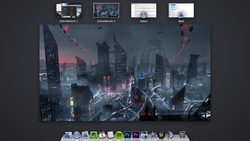Mission Control (Apple)
| Mission Control
|
|
|---|---|
 Mission Control on OS X Mavericks |
|
| Basic data
|
|
| developer | Apple Inc. |
| operating system | macOS |
| category | Window management function |
| support.apple.com/kb/HT4689?viewlocale=ru_RU&locale=en_US | |
Mission Control is a function for the overview of open windows and full-screen apps of macOS , which was introduced with Mac OS X Panther 10.3 and was called "Exposé" up to version 10.6.
After pressing a key combination (standard F3, formerly F9) either all open windows of all active programs or only the windows of the current program in the foreground are reduced and displayed like playing cards on the desktop . The user can then select the window he wants to work with next and continue working with it. Furthermore, all windows can be moved out of the visible area at once to allow unhindered access to the desktop background. Mission Control is also required to manage the virtual desks in OS X, which enables the user to move, delete, or create new desks.
Mission Control can also be started from the launchpad like a normal program, or activated by moving the mouse pointer to a corner of the screen (so-called "active corners").
The display of the windows is updated in real time on computers that support Quartz Extreme . Mission Control, however, also works on computers without Quartz Extreme support.
Mission Control was modeled on other operating systems . So there is iEx for Windows XP and Skippy for Unix (not further developed), Compiz . Windows Vista includes a similar feature that arranges the windows three-dimensionally in a row. The Gnome Shell offers a comparable function with the so-called activities mode.